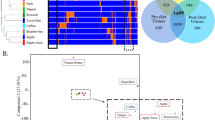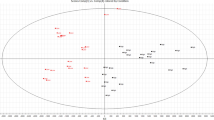Abstract
In the United States, about 25% of infant formula sold is based on soy protein, which is an important source of estrogenic isoflavones in the human food supply. Nevertheless, few studies report isoflavone levels in infants. We did a partly cross-sectional and partly longitudinal pilot study to examine children's exposure to isoflavones from different feeding methods. A total of 166 full-term infants between birth and 1 year of age were recruited into soy formula, cow milk formula, or breast milk regimens according to their feeding histories. A total of 381 urine, 361 saliva, and 88 blood samples were collected at 382 visits. We used automated online solid-phase extraction coupled to high-performance liquid chromatography–tandem mass spectrometry (HPLC–MS/MS) for measuring three isoflavones (daidzein, genistein, and equol) in urine, and used similar LC/MS/MS techniques for saliva and blood spots. Concentrations of daidzein and genistein were undetectable in most blood or saliva samples from children fed breast milk or cow milk formula. The proportion of non-detectable values was somewhat lower in urine than in the other matrices. Concentrations of equol were detectable only in a few urine samples. For both daidzein and genistein, urine contained the highest median concentrations, followed by blood and then saliva. Urinary concentrations of genistein and daidzein were about 500 times higher in the soy formula-fed infants than in the cow milk formula-fed infants. The correlations between matrices for either analyte were strikingly lower than the correlation between the two analytes in any single matrix. We did not find significant correlations between isoflavone concentrations and the levels of certain hormones in children fed soy formula. Our results, based on much larger numbers of infants, strongly confirm previous reports, but whether phytoestrogens in soy formula are biologically active in infants is still an open question. We plan further longitudinal studies focusing on physical and developmental findings reflecting the effects of estrogen exposure.
This is a preview of subscription content, access via your institution
Access options
Subscribe to this journal
Receive 6 print issues and online access
$259.00 per year
only $43.17 per issue
Buy this article
- Purchase on Springer Link
- Instant access to full article PDF
Prices may be subject to local taxes which are calculated during checkout






Similar content being viewed by others
References
American Academy of Pediatrics. Committee on Nutrition. (1998) Soy protein-based formulas: recommendations for use in infant feeding. Pediatrics 101: 148–153.
Anderson R.L., and Wolf W.J. Compositional changes in trypsin inhibitors, phytic acid, saponins and isoflavones related to soybean processing. J Nutr 1995: 125: 581S–588S.
Balk E., Chung M., Chew P., Ip S., Raman G., Kupelnick B., Tatsioni A., Sun Y., Devine D., and Lau J. Effects of soy on health outcomes. Evid Rep Technol Assess (Summ) 2005, 1–8.
Cook D.A. Soy protein in feeding the elderly. J Am Oil Chem Soc 1981: 58: 464–467.
Cruz M.L., Wong W.W., Mimouni F., Hachey D.L., Setchell K.D., Klein P.D., and Tsang R.C. Effects of infant nutrition on cholesterol synthesis rates. Pediatr Res 1994: 35: 135–140.
Franke A.A., and Custer L.J. Daidzein and genistein concentrations in human milk after soy consumption. Clin Chem 1996: 42: 955–964.
Franke A.A., Custer L.J., and Hundahl S.A. Determinants for urinary and plasma isoflavones in humans after soy intake. Nutr Cancer 2004: 50: 141–154.
Franke A.A., Halm B.M., Custer L.J., Tatsumura Y., and Hebshi S. Isoflavones in breastfed infants after mothers consume soy. Am J Clin Nutr 2006: 84: 406–413.
Halm B.M., Ashburn L.A., and Franke A.A. Isoflavones from soya foods are more bioavailable in children than adults. Br J Nutr 2007: 98: 998–1005.
Helsel D.R. Nondetects And Data Analysis: Statistics for Censored Environmental Data. John Wiley & Sons Inc., Hoboken, New Jersey, (2004).
Hutchins A.M., Slavin J.L., and Lampe J.W. Urinary isoflavonoid phytoestrogen and lignan excretion after consumption of fermented and unfermented soy products. J Am Diet Assoc 1995: 95: 545–551.
Irvine C.H., Shand N., Fitzpatrick M.G., and Alexander S.L. Daily intake and urinary excretion of genistein and daidzein by infants fed soy- or dairy-based infant formulas. Am J Clin Nutr 1998: 68: 1462S–1465S.
Klein K.O. Isoflavones, soy-based infant formulas, and relevance to endocrine function. Nutr Rev 1998: 56: 193–204.
Kuklenyik Z., Ye X., Reich J.A., Needham L.L., and Calafat A.M. Automated online and off-line solid-phase extraction methods for measuring isoflavones and lignans in urine. J Chromatogr Sci 2004: 42: 495–500.
Kurzer M.S., and Xu X. Dietary phytoestrogens. Annu Rev Nutr 1997: 17: 353–381.
Lubin J.H., Colt J.S., Camann D., Davis S., Cerhan J.R., Severson R.K., Bernstein L., and Hartge P. Epidemiologic evaluation of measurement data in the presence of detection limits. Environ Health Perspect 2004: 112: 1691–1696.
Mayr U., Butsch A., and Schneider S. Validation of two in vitro test systems for estrogenic activities with zearalenone, phytoestrogens and cereal extracts. Toxicology 1992: 74: 135–149.
Merritt R.J., and Jenks B.H. Safety of soy-based infant formulas containing isoflavones: the clinical evidence. J Nutr 2004: 134: 1220S–1224S.
Miniello V.L., Moro G.E., Tarantino M., Natile M., Granieri L., and Armenio L. Soy-based formulas and phyto-oestrogens: a safety profile. Acta Paediatr Suppl 2003: 91: 93–100.
National Research Council. Hormonally Active Agents in the Environment. National Academy Press, Washington, DC, 1999.
Setchell K.D., Faughnan M.S., Avades T., Zimmer-Nechemias L., Brown N.M., Wolfe B.E., Brashear W.T., Desai P., Oldfield M.F., Botting N.P., and Cassidy A. Comparing the pharmacokinetics of daidzein and genistein with the use of 13C-labeled tracers in premenopausal women. Am J Clin Nutr 2003: 77: 411–419.
Setchell K.D., Zimmer-Nechemias L., Cai J., and Heubi J.E. Isoflavone content of infant formulas and the metabolic fate of these phytoestrogens in early life. Am J Clin Nutr 1998: 68: 1453S–1461S.
Setchell K.D.R., Zimmer-Nechemias L., Cai J., and Heubi J.E. Exposure of infants to phyto-oestrogens from soy-based infant formula. Lancet 1997: 350: 23–27.
Strom B.L., Schinnar R., Ziegler E.E., Barnhart K.T., Sammel M.D., Macones G.A., Stallings V.A., Drulis J.M., Nelson S.E., and Hanson S.A. Exposure to soy-based formula in infancy and endocrinological and reproductive outcomes in young adulthood. J Am Med Assoc 2001: 286: 807–814.
Thomas J.A. Phytoestrogens and hormonal modulation: a mini-review. Environ Nutr Interact 1997: 1: 5–12.
Twaddle N.C., Churchwell M.I., and Doerge D.R. High-throughput quantification of soy isoflavones in human and rodent blood using liquid chromatography with electrospray mass spectrometry and tandem mass spectrometry detection. J Chromatogr B Analyt Technol Biomed Life Sci 2002: 777: 139–145.
Venkataraman P.S., Neylan M.J., Carlson J., and Setchell K.D. Urinary phytoestrogen excretion in infants—differences between human-milk, cow milk based, and soy based formula fed infants. Clin Res 1992: 40: A793–A793. (abstr).
Watanabe S., Yamaguchi M., Sobue T., Takahashi T., Miura T., Arai Y., Mazur W., Wahala K., and Adlercreutz H. Pharmacokinetics of soybean isoflavones in plasma, urine and feces of men after ingestion of 60 g baked soybean powder (kinako). J Nutr 1998: 128: 1710–1715.
Welshons W.V., Rottinghaus G.E., Nonneman D.J., Dolan-Timpe M., and Ross P.F. A sensitive bioassay for detection of dietary estrogens in animal feeds. J Vet Diagn Invest 1990: 2: 268–273.
Wolff A., Begleiter A., and Moskona D. A novel system of human submandibular/sublingual saliva collection. J Dent Res 1997: 76: 1782–1786.
Xu X., Wang H.J., Murphy P.A., Cook L., and Hendrich S. Daidzein is a more bioavailable soymilk isoflavone than is genistein in adult women. J Nutr 1994: 124: 825–832.
Acknowledgements
We are grateful to Zsuzsanna Kuklenyik and John Reidy for the isoflavone measurements in urine and to Liza Valentin-Blasini for helpful discussions.
Author information
Authors and Affiliations
Corresponding author
Additional information
The contents are solely the responsibility of the authors and do not necessarily represent the official views of the CDC.
Conflict of interest
These authors state no conflict of interest.
Rights and permissions
About this article
Cite this article
Cao, Y., Calafat, A., Doerge, D. et al. Isoflavones in urine, saliva, and blood of infants: data from a pilot study on the estrogenic activity of soy formula. J Expo Sci Environ Epidemiol 19, 223–234 (2009). https://doi.org/10.1038/jes.2008.44
Received:
Accepted:
Published:
Issue Date:
DOI: https://doi.org/10.1038/jes.2008.44
Keywords
This article is cited by
-
Saliva Collection Methods Among Children and Adolescents: A Scoping Review
Molecular Diagnosis & Therapy (2024)
-
Early-life exposures and age at thelarche in the Sister Study cohort
Breast Cancer Research (2021)
-
Endocrine Disruptors–‘Food’ for Thought
Proceedings of the Zoological Society (2021)
-
Regulation of hepatic P-gp expression and activity by genistein in rats
Archives of Toxicology (2020)
-
Association between parental self-reported knowledge on soy and phytoestrogen and their children's intake of soy-based infant formulae—a cross-sectional study of Israeli parents
International Journal of Public Health (2020)



